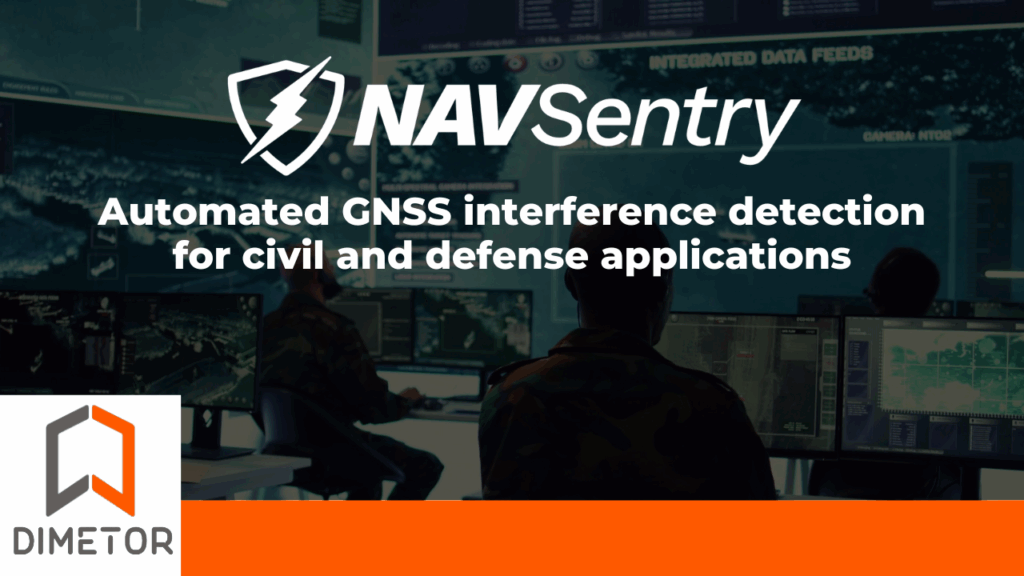A recent report from the International Air Transport Association (IATA) documented over 430,000 GNSS jamming and spoofing incidents in 2024 – a staggering 62% increase from the previous year – disrupting 56 out of every 1,000 flights, especially in conflict zones. In today’s age of electronic warfare, GPS jamming is no longer a theoretical concern, it’s a real and immediate threat.
But this is relevant for more than aviation. GNSS and the associated PNT (position, navigation and timing) services are the critical infrastructure to keep the world running. Aviation, drones, first responders, logistics & transportation, energy grids, shipping and & maritime, agricultural automation, remote operations, government & defense services. They all depend on reliable GNSS without interference.
Detection of GNSS interference has been a costly and difficult exercise, utilizing highly sophisticated and therefore not widely deployed measurement hubs. This is where NAVSentry stands out as a game-changer.
NAVSentry is an operational, wide-area GNSS interference monitoring, detection and alerting system that changes the way GNSS jamming and spoofing is identified and analyzed.
And here is why:
1. Live situational awareness with high temporal and geographical resolution
One of NAVSentry’s most impactful features is its ability to deliver real-time situational awareness. Unlike traditional systems that rely on event-based reporting (such as ADS-B based analysis), NAVSentry provides live large scale sensor network-based feedback on interference, spoofing, or jamming events, pinpointing not just the what, but the where, when, and how. Whether the threat is stationary or moving, NAVSentry identifies it in real time, offering civil and defense operators actionable intelligence on the fly.
This unprecedented granularity and immediacy mean that forces can respond swiftly, deploy resources more efficiently, and maintain a tactical edge. From monitoring sensitive zones to protecting critical infrastructure, NAVSentry brings transparency to electromagnetic interference landscapes.
This operational capability isn’t theoretical. NAVSentry has been successfully deployed and tested on military grounds.
2. No additional hardware needed
NAVSentry stands out by using existing nationwide telecom infrastructure. With access to tens of thousands of passive and active sensors already embedded in different networks, there’s no need to deploy additional costly hardware or build bespoke networks. This “invisible infrastructure” offers both economic and operational scalability. Whether it’s urban centers or remote terrain, NAVSentry is always connected. This approach not only reduces deployment costs but also enables seamless and continuous operation across vast geographical areas.
For example, NAVSentry taps into thousands or even tens of thousands of telecom-embedded sensors – subject to the size of the country – all of which are continuously connected. This persistent visibility ensures real-time intelligence across a dense network without any new infrastructure deployment.
3. 24/7 Nationwide coverage with multi sensor fusion and built-in redundancy
NAVSentry offers continuous, round-the-clock visibility across entire national territories thanks to its integration with mobile and satellite networks. This ensures uninterrupted detection and tracking, even in scenarios where conventional systems might fail.
Furthermore, its hybrid approach brings high redundancy. The multi-sensor fusion in NAVSentry complements existing high-profile military detection systems by integrating telecom sensor data with defense infrastructure, ADS-B and even satellite based detection. This fusion creates a holistic view of the electromagnetic environment for the entire airspace, ensuring that if one system is compromised, others fill in the gaps. It’s a resilient mesh that guarantees operational reliability even under electronic warfare conditions.
4. Mission-ready integration: embedded into civil and defense control systems
NAVSentry is a modular data layer designed to integrate directly into mission control, flight management, UTM/ATM, and command-and-control systems. It ensures that operators are not switching between siloed platforms but instead working within a unified interface that enhances coordination and mission efficacy.
By embedding NAVSentry into defense systems, forces gain seamless access to interference data, threat forecasts, and actionable alerts within their existing workflows while eliminating delays, reducing complexity, and boosting decision-making speed.
Situational awareness is decisive, because you can’t defend what you can’t detect!
5. Predictive threat detection: a new safety paradigm
Beyond reactive detection, NAVSentry introduces a predictive layer powered by AI. Its intelligence can detect not only known spoofing and jamming but also anomalies caused by solar activity, faulty electronics, or unknown interference sources.
Even in areas where no aircraft or drone is present, NAVSentry’s ground-based sensors provide insight into potential threats. This forward-looking capability changes the safety paradigm: defense operators are no longer limited to incident-based awareness, and pathologic or reactive actions. They can now forecast vulnerabilities and adjust tactics, effectively turning the electromagnetic environment into a predictable and manageable domain.
Conclusion: a strategic asset for modern defense
Detection, localization and characterization of interfering signals has become critical for both civil use of GNSS / GPS, and particularly to defense applications. NAVSentry brings a revolutionary approach to electromagnetic situational awareness. From leveraging existing infrastructure for cost-effective deployment to embedding predictive intelligence into the cyber defense stack, it represents a leap forward in critical civil infrastructure and electronic warfare preparedness. As global defense strategies increasingly hinge on speed, data, and resilience, solutions like NAVSentry are becoming necessities. In the new age of hybrid threats, NAVSentry equips governmental organizations and military operators with the visibility, intelligence, and agility to stay ahead of adversaries and protect critical assets at all times.

